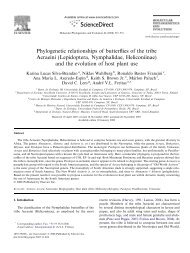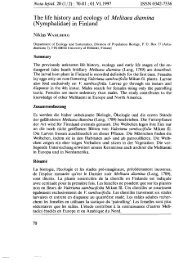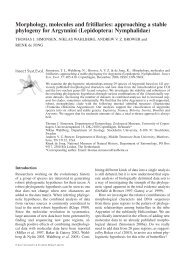Varying rates of diversification in the genus Melitaea (Lepidoptera ...
Varying rates of diversification in the genus Melitaea (Lepidoptera ...
Varying rates of diversification in the genus Melitaea (Lepidoptera ...
Create successful ePaper yourself
Turn your PDF publications into a flip-book with our unique Google optimized e-Paper software.
VARYING RATE OF SPECIATION IN MELITAEA 351<br />
C<br />
A<br />
C<br />
A<br />
<strong>the</strong> null hypo<strong>the</strong>sis <strong>of</strong> vicariance as an explanation for<br />
<strong>diversification</strong> events. We used <strong>the</strong> program DIVA,<br />
version 1.1 (dispersal-vicariance analysis; Ronquist,<br />
1997), which was previously used <strong>in</strong> a number <strong>of</strong><br />
recent studies on butterflies (Braby & Pierce, 2007;<br />
Wahlberg & Freitas, 2007; Kodandaramaiah &<br />
Wahlberg, 2009). The program assigns a cost <strong>of</strong> 0 for<br />
vicariance and sympatric l<strong>in</strong>eage divergence and a<br />
cost <strong>of</strong> 1 for dispersal and ext<strong>in</strong>ction and <strong>the</strong> least cost<br />
ancestral state reconstruction is assumed to be <strong>the</strong><br />
most probable. This means that <strong>the</strong> <strong>in</strong>ferred historical<br />
dispersal events are based on a conservative<br />
hypo<strong>the</strong>sis.<br />
The total present geographical distribution <strong>of</strong> <strong>the</strong><br />
<strong>genus</strong> <strong>Melitaea</strong> was divided <strong>in</strong> to four zones accord<strong>in</strong>g<br />
to <strong>the</strong> knowledge <strong>of</strong> <strong>the</strong> distribution <strong>of</strong> extant endemic<br />
species (Fig. 1). The estimated ancestral range was<br />
restricted dur<strong>in</strong>g <strong>the</strong> DIVA analysis (command ‘maxareas’)<br />
to <strong>the</strong> observed present maximal taxon area<br />
distribution (i.e. two zones).<br />
RESULTS<br />
THE SYSTEMATICS OF MELITAEA<br />
The parsimony analyses conducted with TNT on <strong>the</strong><br />
comb<strong>in</strong>ed dataset <strong>of</strong> <strong>the</strong> three genes resulted <strong>in</strong> 16<br />
equally parsimonious phylogenetic trees <strong>of</strong> 5535 steps<br />
long (CI = 0.29, RI = 0.61). The strict consensus tree is<br />
compared with <strong>the</strong> Bayesian phylogenetic <strong>in</strong>ference <strong>in</strong><br />
Figure 2. The two topologies are broadly congruent,<br />
although <strong>the</strong> Bayesian <strong>in</strong>ference appears to produce<br />
more resolution for some nodes where <strong>the</strong> polytomies<br />
are resolved with strong posterior probabilities. The<br />
same nomenclature has been used to refer to different<br />
B<br />
D<br />
Tibetan<br />
Plateau<br />
Sou<strong>the</strong>rn extension limit<br />
Figure 1. Map show<strong>in</strong>g <strong>the</strong> maximal extension <strong>of</strong> <strong>the</strong><br />
sampled species belong<strong>in</strong>g to <strong>the</strong> <strong>genus</strong> <strong>Melitaea</strong> <strong>in</strong><br />
Eurasia and Nor<strong>the</strong>rn Africa. The map shows also <strong>the</strong><br />
subdivisions used <strong>in</strong> our study. A, Western Palaearctic,<br />
exclud<strong>in</strong>g North African zone. B, Central Palaearctic,<br />
<strong>in</strong>clud<strong>in</strong>g Tibetan Plateau. C, Nor<strong>the</strong>rn Africa. D, Eastern<br />
Palaearctic.<br />
taxonomic levels (Higg<strong>in</strong>s, 1981), <strong>of</strong>ten <strong>in</strong> a confus<strong>in</strong>g<br />
manner. To facilitate discussion, we refer to <strong>in</strong>formal<br />
species groups by <strong>the</strong> names def<strong>in</strong>ed <strong>in</strong> Figure 2B. We<br />
have chosen <strong>the</strong>se groups based on <strong>the</strong>ir stability<br />
to method <strong>of</strong> analysis and <strong>the</strong> robustness <strong>of</strong> <strong>the</strong>ir<br />
monophyly.<br />
The <strong>genus</strong> <strong>Melitaea</strong> as circumscribed by Wahlberg<br />
& Zimmermann (2000) is, by all analysis made for <strong>the</strong><br />
present study, strongly supported as a monophyletic<br />
group with respect to <strong>the</strong> outgroups used. It is primarily<br />
subdivided <strong>in</strong>to two sister clades that are<br />
robust, which we call <strong>the</strong> <strong>Melitaea</strong> and Didymaeformia<br />
clades (Fig. 2). The <strong>Melitaea</strong> clade br<strong>in</strong>gs<br />
toge<strong>the</strong>r 27 sampled species that were previously<br />
placed <strong>in</strong> <strong>the</strong> ‘subgenera’ <strong>Melitaea</strong> and Mellicta. <strong>Melitaea</strong><br />
(sensu Higg<strong>in</strong>s) is <strong>in</strong>ferred to be polyphyletic<br />
after our analyses <strong>in</strong> both regard to <strong>the</strong> position <strong>in</strong><br />
<strong>the</strong> branch (Fig. 2) and to <strong>the</strong> fact that <strong>Melitaea</strong><br />
romanovi, <strong>Melitaea</strong> av<strong>in</strong>ovi, <strong>Melitaea</strong> ardu<strong>in</strong>na, and<br />
<strong>Melitaea</strong> lutko, traditionally part <strong>of</strong> this subgroup are<br />
spread <strong>in</strong> <strong>the</strong> Didymaeformia clade. It has been here<br />
divided <strong>in</strong>to five clades: <strong>the</strong> widespread <strong>Melitaea</strong><br />
c<strong>in</strong>xia (c<strong>in</strong>xia group), <strong>the</strong> diam<strong>in</strong>a group (<strong>in</strong>clud<strong>in</strong>g<br />
<strong>Melitaea</strong> protomedia), <strong>the</strong> arcesia group (that <strong>in</strong>cludes<br />
<strong>Melitaea</strong> chuana, <strong>Melitaea</strong> bellona, <strong>Melitaea</strong><br />
amoenula, as well as <strong>Melitaea</strong> leechi), <strong>the</strong> m<strong>in</strong>erva<br />
group (<strong>Melitaea</strong> elizabethae, <strong>Melitaea</strong> solona, <strong>Melitaea</strong><br />
ludmilla, <strong>Melitaea</strong> sultanensis, and <strong>Melitaea</strong> pallas)<br />
and, f<strong>in</strong>ally, <strong>the</strong> athalia species group [compris<strong>in</strong>g all<br />
species <strong>in</strong> <strong>the</strong> Mellicta <strong>of</strong> Higg<strong>in</strong>s (1955)]. The athalia<br />
group is sister to <strong>the</strong> m<strong>in</strong>erva group; it is monophyletic<br />
and is clearly a subgroup <strong>of</strong> <strong>the</strong> <strong>Melitaea</strong> clade; a<br />
result that is globally congruent with Wahlberg &<br />
Zimmermann (2000). The group has previously been<br />
described by Higg<strong>in</strong>s (1955), who provided an overview<br />
<strong>of</strong> this homogenous clade. A noteworthy result <strong>in</strong><br />
<strong>the</strong> athalia group is that <strong>Melitaea</strong> celadussa, which is<br />
usually considered a subspecies <strong>of</strong> <strong>Melitaea</strong> athalia<br />
(Higg<strong>in</strong>s, 1941, 1955; Lafranchis, 2000), is not<br />
directly related to M. athalia. Our analyses show that<br />
M. athalia is more closely related to <strong>Melitaea</strong> caucasogenita<br />
and <strong>Melitaea</strong> ambigua, this species group<br />
be<strong>in</strong>g sister to <strong>the</strong> <strong>Melitaea</strong> deione/<strong>Melitaea</strong> britomartis<br />
branch, and f<strong>in</strong>ally M. celadussa be<strong>in</strong>g sister to<br />
that clade (Fig. 2).<br />
The Didymaeformia clade comprises Higg<strong>in</strong>s’<br />
(1941) didyma, fergana, coll<strong>in</strong>a and phoebe speciesgroups,<br />
which he subsequently split <strong>in</strong>to <strong>the</strong> genera<br />
Didymaeformia and C<strong>in</strong>clidia (Higg<strong>in</strong>s, 1981) (38<br />
species <strong>in</strong>cluded here); <strong>the</strong>se subdivisions found no<br />
support <strong>in</strong> <strong>the</strong> present study, be<strong>in</strong>g respectively paraphyletic<br />
and conta<strong>in</strong>ed with<strong>in</strong> a larger clade as previously<br />
found by Wahlberg & Zimmermann (2000).<br />
<strong>Melitaea</strong> trivia, previously <strong>in</strong>cluded <strong>in</strong> <strong>the</strong> Didymaeformia<br />
<strong>genus</strong> and part <strong>of</strong> <strong>the</strong> coll<strong>in</strong>a group (paraphyletic)<br />
(toge<strong>the</strong>r with M. coll<strong>in</strong>a and <strong>Melitaea</strong> consulis),<br />
© 2009 The L<strong>in</strong>nean Society <strong>of</strong> London, Biological Journal <strong>of</strong> <strong>the</strong> L<strong>in</strong>nean Society, 2009, 97, 346–361





